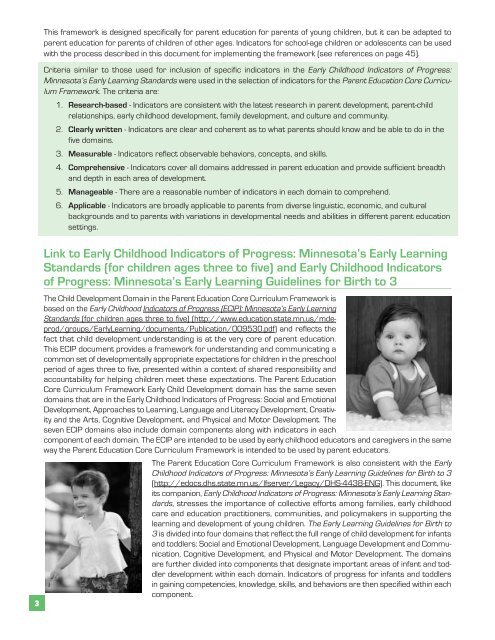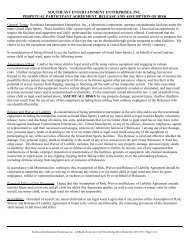Parent Education Core Curriculum Framework 2011.pdf - mnafee
Parent Education Core Curriculum Framework 2011.pdf - mnafee
Parent Education Core Curriculum Framework 2011.pdf - mnafee
You also want an ePaper? Increase the reach of your titles
YUMPU automatically turns print PDFs into web optimized ePapers that Google loves.
This framework is designed specifically for parent education for parents of young children, but it can be adapted to<br />
parent education for parents of children of other ages. Indicators for school-age children or adolescents can be used<br />
with the process described in this document for implementing the framework (see references on page 45).<br />
Criteria similar to those used for inclusion of specific indicators in the Early Childhood Indicators of Progress:<br />
Minnesota’s Early Learning Standards were used in the selection of indicators for the <strong>Parent</strong> <strong>Education</strong> <strong>Core</strong> <strong>Curriculum</strong><br />
<strong>Framework</strong>. The criteria are:<br />
1. Research-based - Indicators are consistent with the latest research in parent development, parent-child<br />
relationships, early childhood development, family development, and culture and community.<br />
2. Clearly written - Indicators are clear and coherent as to what parents should know and be able to do in the<br />
five domains.<br />
3. Measurable - Indicators reflect observable behaviors, concepts, and skills.<br />
4. Comprehensive - Indicators cover all domains addressed in parent education and provide sufficient breadth<br />
and depth in each area of development.<br />
5. Manageable - There are a reasonable number of indicators in each domain to comprehend.<br />
6. Applicable - Indicators are broadly applicable to parents from diverse linguistic, economic, and cultural<br />
backgrounds and to parents with variations in developmental needs and abilities in different parent education<br />
settings.<br />
Link to Early Childhood Indicators of Progress: Minnesota’s Early Learning<br />
Standards (for children ages three to five) and Early Childhood Indicators<br />
of Progress: Minnesota’s Early Learning Guidelines for Birth to 3<br />
The Child Development Domain in the <strong>Parent</strong> <strong>Education</strong> <strong>Core</strong> <strong>Curriculum</strong> <strong>Framework</strong> is<br />
based on the Early Childhood Indicators of Progress (ECIP): Minnesota’s Early Learning<br />
Standards (for children ages three to five) (http://www.education.state.mn.us/mdeprod/groups/EarlyLearning/documents/Publication/009530.pdf)<br />
and reflects the<br />
fact that child development understanding is at the very core of parent education.<br />
This ECIP document provides a framework for understanding and communicating a<br />
common set of developmentally appropriate expectations for children in the preschool<br />
period of ages three to five, presented within a context of shared responsibility and<br />
accountability for helping children meet these expectations. The <strong>Parent</strong> <strong>Education</strong><br />
<strong>Core</strong> <strong>Curriculum</strong> <strong>Framework</strong> Early Child Development domain has the same seven<br />
domains that are in the Early Childhood Indicators of Progress: Social and Emotional<br />
Development, Approaches to Learning, Language and Literacy Development, Creativity<br />
and the Arts, Cognitive Development, and Physical and Motor Development. The<br />
seven ECIP domains also include domain components along with indicators in each<br />
component of each domain. The ECIP are intended to be used by early childhood educators and caregivers in the same<br />
way the <strong>Parent</strong> <strong>Education</strong> <strong>Core</strong> <strong>Curriculum</strong> <strong>Framework</strong> is intended to be used by parent educators.<br />
The <strong>Parent</strong> <strong>Education</strong> <strong>Core</strong> <strong>Curriculum</strong> <strong>Framework</strong> is also consistent with the Early<br />
Childhood Indicators of Progress: Minnesota’s Early Learning Guidelines for Birth to 3<br />
(http://edocs.dhs.state.mn.us/lfserver/Legacy/DHS-4438-ENG). This document, like<br />
its companion, Early Childhood Indicators of Progress: Minnesota’s Early Learning Standards,<br />
stresses the importance of collective efforts among families, early childhood<br />
care and education practitioners, communities, and policymakers in supporting the<br />
learning and development of young children. The Early Learning Guidelines for Birth to<br />
3 is divided into four domains that reflect the full range of child development for infants<br />
and toddlers: Social and Emotional Development, Language Development and Communication,<br />
Cognitive Development, and Physical and Motor Development. The domains<br />
are further divided into components that designate important areas of infant and toddler<br />
development within each domain. Indicators of progress for infants and toddlers<br />
in gaining competencies, knowledge, skills, and behaviors are then specified within each<br />
component.<br />
3





